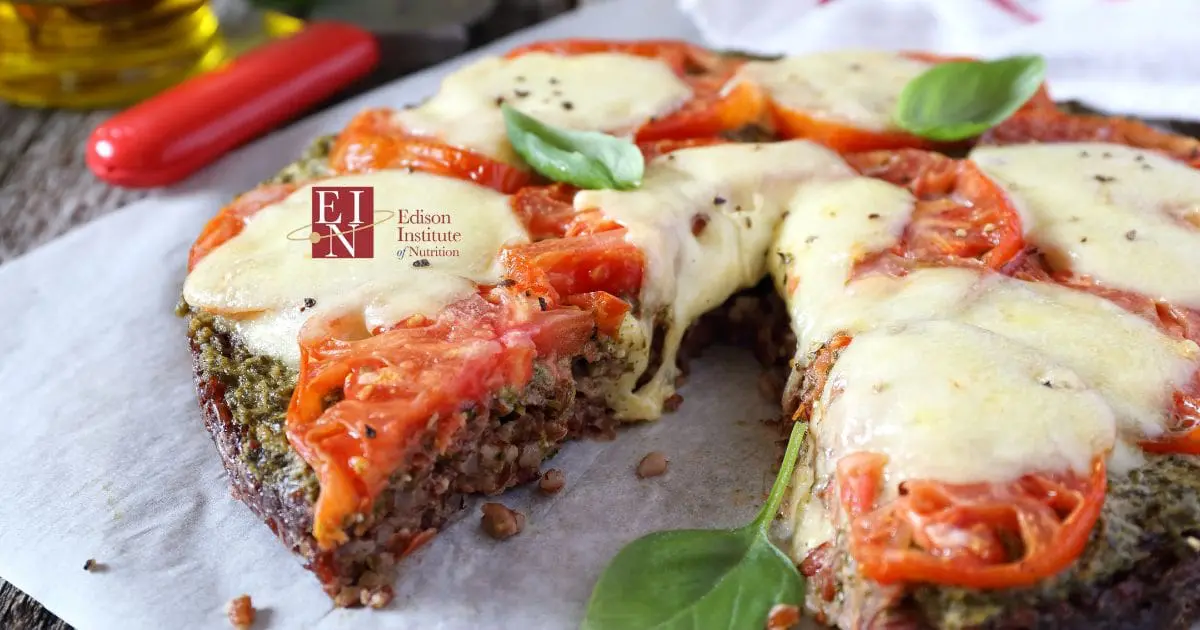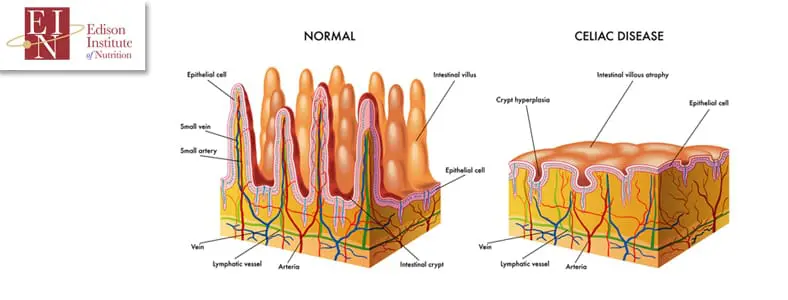 The gluten free diet has exploded in popularity in recent years.
The gluten free diet has exploded in popularity in recent years.
Its proponents say it can dramatically improve your mental state, reduce inflammation, and improve your digestive health.
On the other hand, there are experts who claim it’s all overblown, and outside of a small population of people with certain disorders, going gluten free won’t make much of a difference.
Who’s right?
As a prospective student at the Edison school of holistic nutrition, when you graduate your clients are going to expect you to be able to cut through the fluff and make sense of it all.
So let’s take a closer look at what gluten is, what it does, and how you can advise your clients on how to make the best choices for their health.
What Is Gluten, Anyway?
The word gluten is actually the Latin word for “glue”, which makes a lot of sense considering its sticky consistence when mixed with water.
Remember when you made paper mache in kindergarten – same idea.
Gluten and gliadins (a component of gluten) are proteins which are in a wide variety of grains including wheat, rye, barley, triticale and some oats.
Gliadins are essential for giving bread the ability to rise properly during baking, giving it its chewy consistency and holding it together.
While it’s naturally occurring in the above mentioned grains, it can also be used as an additive in processed foods as a filler and to help give them a stronger consistency.
It’s important to note that gluten doesn’t provide any essential nutrients on its own.
It’s a protein, yes, but for most people in developed nations protein deficiency isn’t an issue.
Why Is Gluten Bad For You?
While there are some people who can eat gluten without any issue, there are others for whom gluten can be a significant problem.
Let’s take a look at some of the reasons why a gluten free diet may be the right way to go.
For People With Celiac Disease
Let’s get this one out of the way right off the bat, since it’s the least controversial.
Celiac disease is an autoimmune disorder, which means your body’s own immune system attacks itself by accident to remove the toxin or culprit.
With celiac disease, the autoimmune reaction is triggered by the presence of gluten and/or gliadin.
In response your immune system attacks your intestines to get the irritant out.
Once this attack begins, the absorptive surface of your small intestine becomes damaged.
The lining of the gut contains millions of tiny tube shaped structures called villi.
These villi help food and nutrients to be digested more effectively into the body.
But in people with a celiac condition the villi become flattened because of the inflammation.
This results in an inability of the body to absorb nutrients: protein, fat, carbohydrates, vitamins, and minerals, which are necessary for good health.
This causes severe digestive issues and nutrient deficiencies that can lead to other issues.
The most common symptoms of Celiac disease are:
- Diarrhea
- Constipation
- Stomach pain
- Skin rashes
- Bloating
- Unexpected weight loss
- Anemia
- Depression due to nutrient deficiencies
- Tiredness
The issue with properly diagnosing celiac disease, is that all the symptoms listed above are also common in other health conditions.
Celiac disease affects about 1% of the population, and the only way to manage it is to eat a strict gluten free diet.
For People With Non Celiac Gluten Sensitivity
If you tested negative for Celiac disease and wheat allergies, you might have non celiac gluten sensitivity.
This condition affects 0.5 to 13% of the population and the symptoms are similar to those that people with Celiac disease experience, including:
- Stomach pain
- Changes in bowel habits
- Bloating
- Tiredness
- Eczema
- Rashes
Because it can cause skin issues, using holistic nutrition as treatment for eczema and other skin issues can involve a gluten free diet.
The symptoms of non celiac gluten sensitivity tend to be less severe than celiac disease, but that doesn’t mean it’s a cakewalk to deal with either.
For People With A Wheat Allergy
A wheat allergy is a gluten related disorder, but it’s a little different than the rest.
With a wheat allergy, your body produces antibodies to all the proteins found in wheat.
This includes gluten, as well as gliadin, prolamin, and secalin.
Its symptoms include:
- Diarrhea
- Cramps
- Nausea
- Vomiting
- Headaches
- Congestion
- Hives and other skin issues
In extreme cases, it can lead to anaphylaxis, a life threatening reaction where your airway tightens and can even close up entirely.
The best way to manage this condition is to avoid wheat proteins – including gluten – entirely.
You may also need to carry an EpiPen in case of a reaction – this is a device full of epinephrine, which can quickly and forcefully reopen your airways in case of anaphylaxis.
For The Rest Of Us
If you don’t have celiac disease, non celiac gluten sensitivity, or a wheat allergy, is gluten safe for you to eat?
Not necessarily.
A 2011 study by O’Malley, Quigley, Dinan, and Cryan found that the presence of gluten triggers an autoimmune response in people who were diagnosed with IBS.
As well, gluten can lead to an increase in intestinal permeability.
Your intestines are porous – it’s how your body extracts nutrients from them and they enter your bloodstream, while keeping other things – bacteria, fecal matter, and other nasty stuff – out.
However, when you eat too much gluten, it can cause your intestines to become too porous, which ends up letting the nasty stuff through as well.
This is what’s known as leaky gut syndrome.
This doesn’t happen with everyone who eats gluten, but if you notice the following symptoms, it might benefit you to go gluten free:
- Chronic diarrhea
- Constipation
- Bloating
- Chronic fatigue
- Chronic headaches
- Acne
- Eczema
- Joint pain
Benefits Of Going Gluten Free
After learning about gluten and the kind of issues it can cause to some people, let’s now talk about the benefits of a gluten free diet.
1. To Relieve Digestive Symptoms
People with celiac disease, non celiac gluten sensitivity, and leaky gut syndrome can ease their digestive problems by following a gluten free diet which will help reduce the inflammation and damage to microvilli.
The most common issues a gluten free diet can help with are:
- Diarrhea
- Bloating
- Gas
- Constipation
- Fatigue
Studies have shown that the symptoms mentioned above can significantly decrease after following a gluten free diet for six months.
2. To Lose Weight
Losing weight is a logical result from following a gluten free diet, since many junk foods get replaced by vegetables, fruits and lean proteins, and people no longer consume unwanted calories.
However, there are many products out there like cake, pastries and snacks that are gluten free.
It’s important to note that “gluten free” doesn’t necessarily mean healthy or gliadin free.
The best foods to eat while on a gluten free diet, or any other diet for that matter, are whole foods like vegetables, fruits and lean proteins.
3. To Manage Chronic Inflammation
Inflammation is the body’s natural response to fight infections, but when it gets out of hand it can become chronic and cause many health problems.
Many studies have shown that a gluten free diet can reduce inflammation and help repair the damage caused to the gut in people with celiac disease.
There is ongoing research into non celiac gluten sensitivity to understand what’s triggering the reaction – it might be the gluten itself, or a compound that commonly occurs alongside gluten.
Most often it starts with the early introduction (before 18 months of age) of cereal grains, breads crackers, or any other grain products.
Prior to 18 months of age, children don’t make the necessary enzymes to break down and digest grain products.
Regardless of the cause, however, removing gluten from your diet can help manage your symptoms.
4. To Improve Energy Levels
As mentioned previously, one of the symptoms people with gluten related conditions experience is tiredness.
This may be caused by anemia or nutrient deficiencies after the gut is damaged.
A gluten free diet can help people with gluten related conditions to feel more energetic and less sluggish.
As a result, a common method for using holistic nutrition for chronic fatigue syndrome is to remove gluten from your diet.

How To Create A Gluten Free Diet Plan
If you are having trouble finding the right foods to eat to start your gluten free journey, here’s a step by step guide on how to do it.
Let’s take a closer look at how to create a gluten free diet plan.
1. Eliminate All Sources Of Gluten
Eliminating all gluten from your diet sounds a bit extreme, but if you suffer from gluten intolerance, celiac disease, wheat allergy and non celiac gluten sensitivity, it’s something you must do.
It can also be very challenging since gluten is often added to many common foods at the store, so the best way to avoid it is by eating single ingredient foods.
Here is a list of common foods that contain gluten:
- Bread (wheat based bread)
- Pasta (wheat based)
- Cereals (unless labelled gluten free)
- Baked goods(unless labelled gluten free)
- Snack foods (candy, muesli bars, crackers, pre packaged convenience foods, roasted nuts, flavored chips, popcorn, pretzels).
- Sauces (soy sauce, marinades, salad dressings)
- Beverages (most beer, flavoured alcoholic beverages)
Also, oats might contain gluten if they are processed in the same facility as wheat based foods, but they are naturally gluten free.
2. Avoid Gluten Free Alternatives
While a gluten free diet sounds healthy, it often doesn’t help with nutritional deficiencies if you just buy processed junk foods that are labelled as gluten free.
Just like with holistic nutrition for vegetarians and vegans, for the paleo diet, the keto diet, and many others, a “gluten free” label doesn’t mean it’s healthy.
Take gluten free bread, for example – the gluten serves an important role in helping the bread maintain its structural integrity.
Remove that, and the bread will just crumble, so you need to replace it with something else to hold it together.
In most gluten free breads, this means tapioca starch, potato starch, rice flour, or corn starch.
And while these might not trigger a gluten reaction, none of them is particularly good for you either.
3. …And Focus On Whole Foods
Whole foods should definitely be on your shopping list if you are going to start a gluten free diet.
There are many whole foods that are naturally gluten free, for example:
- Unprocessed meats and fish (except battered meats)
- Eggs
- All fruits and vegetables
- Quinoa
- Brown rice
- Wild rice
- Buckwheat
- Millet
- Arrowroot
- Oats (but make sure they aren’t processed in a facility that also processes wheat)
- Nuts and seeds
- Cooking oils
- Butter
- Herbs and spices
4. Make Sure To Get Enough Fibre
A common side effect of the gluten free diet is constipation.
This is because foods that contain gluten tend to be pretty high in fibre as well.
But that doesn’t mean these are the only sources of fibre out there.
If you’re writing a gluten free diet plan for a client, be sure it includes plenty of:
- Broccoli
- Beans
- Lentils
- Flaxseeds
- Brussels sprouts
- Berries
- All vegetables and fruits
Contact The Edison Institute Of Nutrition Today
Are you considering changing careers to become a registered holistic nutritionist?
There are plenty of great career opportunities for Edison graduates, and we can help you explore your options.
Contact us at The Edison Institute of Nutrition today to find out more.
